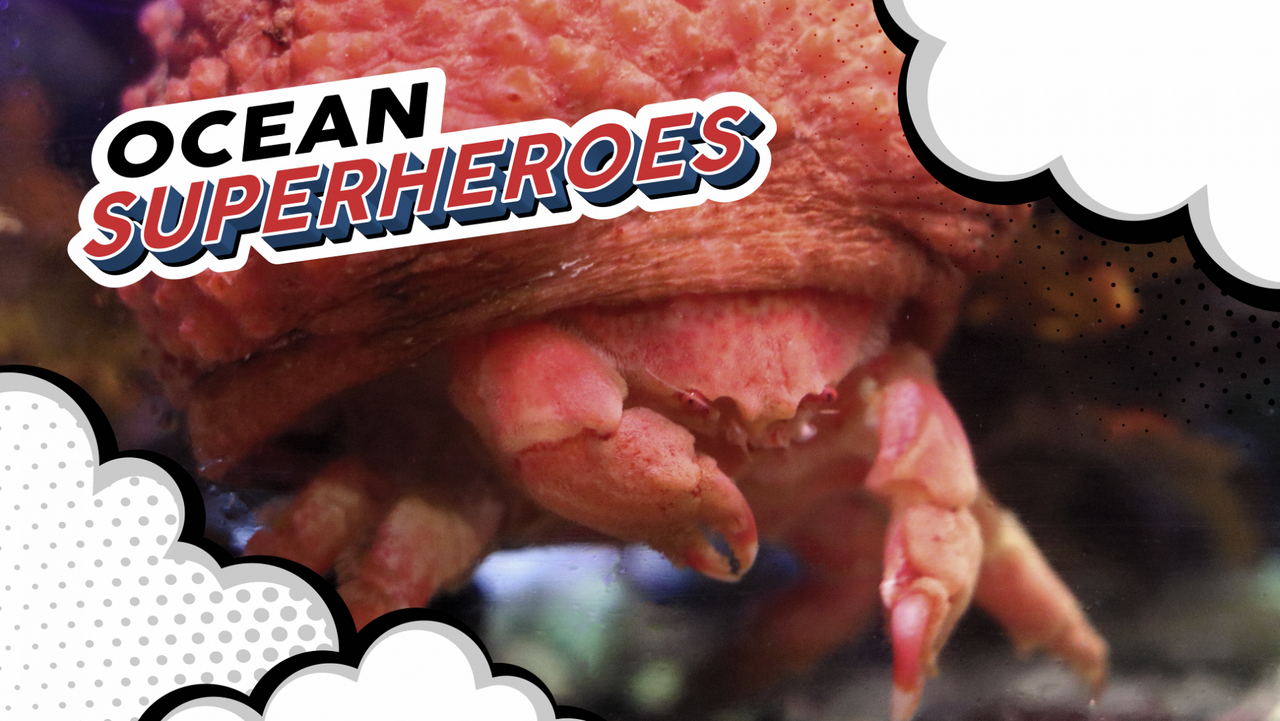Some wear the shells of other animals...
Some are so large that their shell makes them invulnerable...
Some grow their own shells from sea sponges...
When you hear the word "crab", you might think of something rather stereotypical - a flattened crustacean with two pincers and six legs that scuttles around on the beach - but we're here to show you that there's plenty more diversity to this understated group of #OceanSuperheroes than you may realise.

Crabs belong to a group of animals called "decapods", literally ten-legged crustaceans which include other ocean dwellers like shrimp, prawns, crayfish and lobsters. Because of the diversity of the decapods, the word "crab" is often used to describe animals that have a similar appearance but are not closely related (similar to the situation with eels). True crabs, belonging to the infraorder Brachyura (meaning "short-tailed" - because they lack the long tails of lobsters and prawns) - a family with almost 7 000 species! That means crabs have a greater species diversity than us mammals do.
Crab fact: Crabs are found everywhere, from the Antarctic to the tropics - some crabs even live their whole lives on land! They range in size from the giant spider crab with a leg span of over 4m, to the pea crab which grows to only a few millimetres.
One of the reasons crabs are rarely seen in the large exhibits at the Two Oceans Aquarium, except the occasional hidden gem in the Kelp Forest Exhibit, is that many fish specialise in hunting these bottom-dwelling crustaceans. For crabs to thrive at the Aquarium, we instead select unusual species that deserve their own special ecosystem, away from those pesky predators. Take a look at a few of the wonderful crabs in our care.
Sponge crab
Topping this list of unusual crabs is the cloaked sponge crab (Pseudodromia latens). The sponge crabs family belongs to the true crabs and is characterised by the unique ability to trim pieces of wild sea sponge, attach these pieces to the crab's carapace and then cultivate the sponge to grow into additional protective layers. The cloaked sponge crab is no exception to this, almost completely enclosing itself in a ball of its favourite Southern Cape sponges.
Crab fact: A group of crabs is called a "cast".
The cloaked sponge crab feeds on sea fans, and can often be found climbing them. Its choice of sea sponge helps it to camouflage itself in this environment - as seen in the sponge crab habitat in the Skretting Diversity Gallery.
If viewed from below, the sponge crab's back pair of legs are much longer than the others and have an upward curve. These legs are used to hold the pieces of sponge in place as they grow securely onto the crab's shell.
Hermit crab
This might come as a surprise: The hermit crab is not actually a crab. The hermit crab belongs to the superfamily Paguroidea (which means "resembling a crab") and although it is not a true crab, this superfamily is also incredibly diverse, with over 1 000 living species of hermit crab found today.
The hermit crab has a soft, curved body that allows it to squeeze into empty snail shells for added protection, with just its head and legs sticking out. Because the "perfect shell" is hard to find, the hermit crab will often fight another hermit crab to claim one. In some species, if a small hermit crab finds a big shell it will wait next to the shell for a larger crab to claim it - then the little crab can take the now-abandoned shell. Like the sponge crab, many hermit crabs stick other animals to these shells for added protection, with a particular preference for anemones.
The Two Oceans Aquarium's striated hermit crab (Dardanus arrosor) belongs to one of the larger species of hermit crabs and is easily identified by its orange-red colour, spikey striations on its pincers and red and white bands on its eye-stalks. The striated hermit crab is a scavenger, like most other hermits, but because of its large size, it is also easily able to overpower and feed on smaller crabs that it encounters.
Giant spider crab
By far the most famous crab at the Two Oceans Aquarium, the giant spider crab (Macrocheira kaempferi) is a magnificent guest all the way from Japan! This crab is truly the king of the crustaceans, easily growing larger than any other crustacean species. Its legs can span up to 4m!
Learn more about how these giant crabs arrived at the Two Oceans Aquarium.
Although this spider crab is colossal, being a giant isn't without its difficulties. Its large size and thick armour make the giant spider crab essentially invulnerable to predation most of the time, but when it grows too large it needs to shed its shell and allow a new one to harden. All crustaceans do this, but due to its large size this is a particularly difficult task for the giant spider crab. Sometimes the giant spider crab is unable to climb out of its old carapace, instead becoming trapped and drowning, or falling victim to an attack by a predator or rival crab.
Here's everything you could ever want to know about giant spider crabs.
Want to learn more about all sorts of Ocean Superheroes? Check out the fun at the Two Oceans Aquarium.




